Birds

Bald Eagle / Osprey (breeding)
This priority population group consists of breeding Bald Eagles (Haliaeetus leucocephalus) and Osprey (Pandion haliaetus), two apex predators of great majestic beauty and large size.
Bald Eagles face threats such as lead poisoning from consuming dead carcasses shot by ammunition containing lead, collisions with vehicles and disturbance at nest sites. Osprey face issues of their young chicks becoming entangled by fishing line, which adults use when building their nests.
According to a WDNR report, 8 Bald Eagles bred in Brown County in 2018, though the Wisconsin Breeding Bird Atlas II Project (WBBA2) reported roughly 4-5 nests within the LGBFR AOC boundaries during 2015-2019. Although Osprey do not currently nest in the AOC, they have successfully nested nearby at the Izaak Walton League’s Osprey Point property in Ledgeview in 2015 (WBBA2), have tried building a nest at Bay Beach Wildlife Sanctuary in 2019 (WBBA2) and have been reported during the breeding season at multiple locations throughout the LGBFR AOC according to WBBA2 and eBird records (eBird 2019).
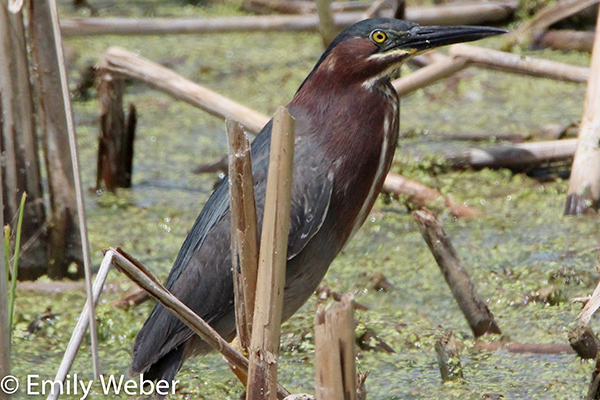
Coastal Birds
Coastal birds are summer resident species that use the nearshore environment for feeding or breeding, including Belted Kingfisher (Megaceryle alcyon), Green Heron (Butorides virescens), Spotted Sandpiper (Actitis macularius), and swallows (including Purple Martin [Progne subis]), Bank Swallow (Riparia riparia) and Northern Rough-winged Swallow (Stelgidopteryx serripennis).
This group is important because coastal birds are predators of aquatic species that depend on the coastal or nearshore environment.
All of the species in this group have been confirmed as breeding in or near the LGBFR AOC during the Wisconsin Breeding Bird Atlas 2 Project between 2015 and 2019 (WBBA2; eBird 2017). Along the west shore of the LGBFR AOC, all seven coastal bird species have been confirmed as breeding (e.g., through the documentation of a nest or observation of a young fledgling). Along the east shore, all but Belted Kingfisher have been documented as breeding, while all seven species are suspected to have bred along the Fox River with the exception of a confirmed Cliff Swallow nesting colony.
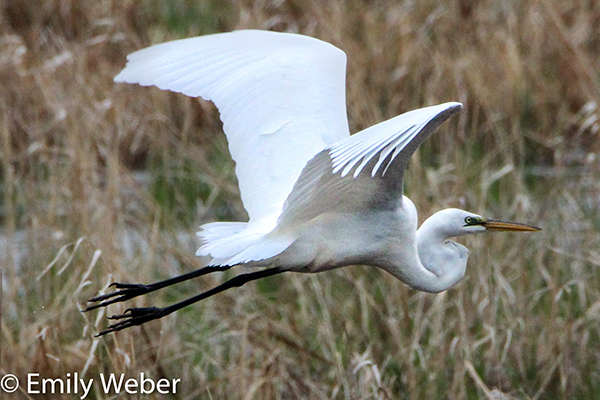
Colonial Waterbirds (breeding season)
The “colonial waterbirds” group refers to waterbirds that nest colonially, typically on islands or in rookeries, though site-specific nesting requirements vary. Species include: American White Pelican (Pelecanus erythrorhynchos), Black-crowned Night-Heron (Nycticorax nycticorax), Caspian Tern (Hydroprogne caspia), Common Tern (Sterna hirundo), Double-crested Cormorant (Phalacrocorax auritus), Great Egret (Ardea alba), Herring Gull (Larus smithsonianus) and Ring-billed Gull (Larus delawarensis).
Due to extremely high water levels in the bay, massive storms, and recently hardened shorelines, most of the Cat Island Chain of islands washed away during the spring of 1973, leaving only Cat and Lone Tree Islands, which persisted and are still present today. In the 1980s, a group of local conservationists proposed the bold idea of reconstructing three barrier islands, formalizing the proposal in the LGBFR AOC’s 1988 RAP. After several decades, the Cat Island Chain Restoration Site’s causeway and borders of island “cells” were constructed in May 2013.
Today, American White Pelican, Double-crested Cormorant and Herring Gull nest on Cat Island proper (T. Prestby, pers. comm., eBird 2017). Nesters on Lone Tree Island include American White Pelican, Double-crested Cormorant, Black-crowned Night-Heron, Great Egret, Herring Gull and Ring-billed Gull (T. Prestby, pers. comm., eBird 2017). Along sections of the easternmost “cell” on the Cat Island Chain Restoration Site, American White Pelican, Caspian Tern, Black-crowned Night-Heron and Herring and Ring-billed Gulls currently nest (T. Prestby, pers. comm., eBird 2017). Just east of the mouth of the Fox River is a large Ring-billed Gull colony on the confined disposal facility (i.e., CDF), Renard Island, formerly known as Kidney Island (T. Prestby, pers. comm.). Both Ring-billed and Herring Gull populations have done extremely well in the past several years due to the introduction of invasive alewife (Alosa pseudoharengus) and rainbow smelt (Osmerus mordax; Qualls et al. 2013). Common Terns have nested on artificial platforms installed and monitored by the WDNR and U.S. Fish and Wildlife Service for the past few years.
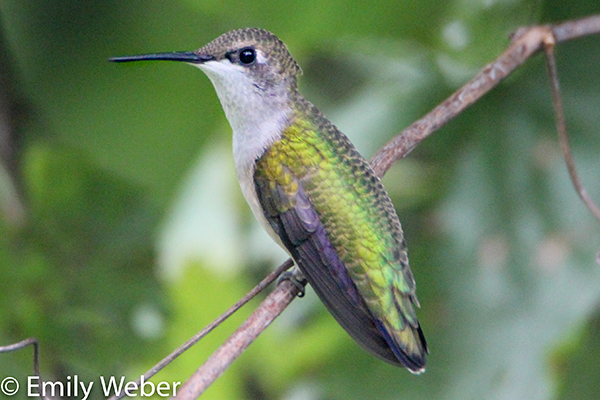
Landbirds (migratory)
The “migratory landbirds” group consists of woodpeckers, cuckoos, nightjars, hummingbirds and perching birds (Order Passeriformes) that use terrestrial habitats as migratory stopover habitat during spring or fall migration.
Although migratory landbirds are broadly abundant in the lower Green Bay coastal zone, we identify six important hotspots:
- Point au Sable
- Bay Beach Wildlife Sanctuary West
- UW-Green Bay’s Cofrin Arboretum, including Bay Shore Woods and Beach and Mahon Woods and Creek on the east shore
- Ken Euers Wildlife Area
- Barkhausen Waterfowl Preserve
- The privately-owned Malchow/Olson Tract on the west shore (Important Bird Areas, Epstein et al. 2002, Beilke 2015, eBird 2017).
Over 200 bird species have been reported at several lower Green Bay migratory landbird hotspots, though the number of species includes waterbirds, raptors, shorebirds and other non-landbirds (eBird 2017).
Planting native shrubs (e.g., cherry [Prunus spp.], dogwood [Cornus spp.], grape [Vitis riparia]) in urban parks and degraded woodlands will increase the availability of quality, nutritional fruits for migrant landbirds, especially during August, September, and October (Drummond 2005). Other steps to improve the condition of migrant landbird populations include 1) encouraging native landscaping in backyards and commercial grounds, 2) conserving hardwood swamps, which provide abundant insects and resting habitat for long-distance migrants, and 3) improving all types of natural habitats in the lower Green Bay coastal zone, especially along shorelines.

Marsh Breeding Birds
The “marsh breeding birds” group consists of birds regularly encountered in emergent marshes, including marsh-obligates and several marsh-users, but excluding wetland-breeding terns (e.g., Black Tern [Chlidonias niger]) and other species (e.g., coastal bird [breeding season], Osprey), which are treated separately. A marsh-obligate is a bird species that only breeds and lives in open marshes and not any other habitat, including species such as American Coot (Fulica americana), Yellow-headed Blackbird (Xanthocephalus xanthocephalus), Virginia Rail (Rallus limicola), Marsh Wren (Cistothorus palustris), Least Bittern (Ixobrychus exilis) and others. In contrast, a marsh-user is a species that may use marshes for foraging and breeding but does not necessarily require open, emergent marshes for breeding (e.g., Common Yellowthroat [Geothlypis trichas], Red-winged Blackbird [Agelaius phoeniceus], Song Sparrow [Melospiza melodia], Blue-winged Teal [Anas discors] and others. Common Yellowthoat, for example, will breed in open wetlands, grassy areas, shrub carr and forests (Guzy and Ritchison 1999).
According to our observations and 2014-2017 data from the Wisconsin Breeding Bird Atlas 2 and local experts (e.g., T. Prestby, pers. comm.), many important marsh breeding birds currently nest in the LGBFR AOC, especially at Peters Marsh, the Duck Creek area, Dead Horse Bay / Longtail Point and Point Sable. Multiple records of Sandhill Crane, Yellow-headed Blackbird and American Coot breeding in the LGBFR AOC have been confirmed, but only one recent breeding record has been confirmed for American Bittern, Gadwall (which was abundant historically), Least Bittern and Virginia Rail (eBird 2017).
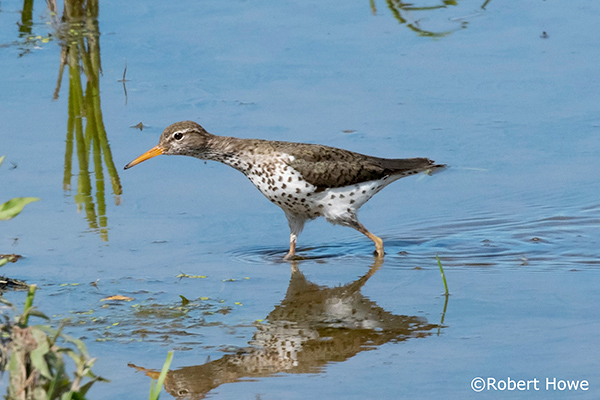
Shorebirds (breeding)
This group includes two common breeders in the LGBFR AOC, Killdeer (Charadrius vociferus) and Spotted Sandpiper (Actitis macularius), as well as any other potential rare breeders, such as Piping Plover (Charadrius melodus) and Wilson's Phalarope (Phalaropus tricolor).
According to the Wisconsin Breeding Bird Atlas II Project (2015-2019), the following species bred at each of the Cat Island Wave Barrier (Killdeer, Spotted Sandpiper, Piping Plover and Wilson’s Phalarope), Longtail Point (Spotted Sandpiper), and Point au Sable (no breeding confirmations of any of these shorebird species). Killdeer and Spotted Sandpiper nested at several other locations in the LGBFR AOC. Piping Plovers nesting at the Cat Island Wave Barrier in 2016 was a momentous event having been the first time in over 75 years. A pair of Wilson’s Phalaropes also nested at Cat Island, which represented one of the only nesting confirmations in the state. Lower Green Bay is an important stronghold for nesting shorebirds.
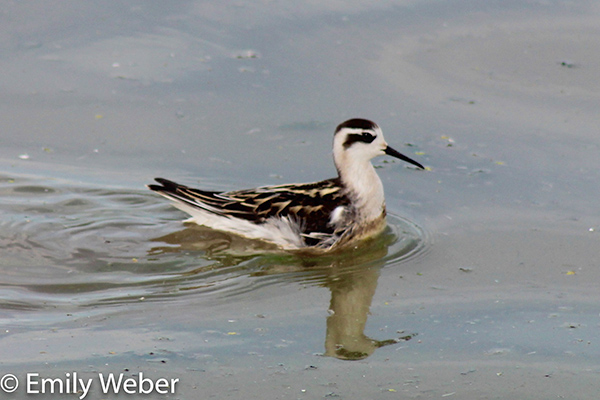
Shorebirds (migratory)
Approximately 25 shorebirds (Order Charadriiformes) regularly use shoreline, coastal and wetland habitats in the LGBFR AOC as stopover habitat during spring or fall migration. This group includes plovers, sandpipers, godwits, dowitchers, yellowlegs, phalaropes and other subgroups.
Thomas Prestby’s (2015) master thesis provided a baseline study of migratory shorebirds in the lower bay, perfectly timed to coincide with the construction of the Cat Island Chain Restoration Site. He documented over 30 species of shorebirds at the Cat Island Chain Restoration Site between 2013 and 2014. In fact, Prestby’s (2015) study showed that the Cat Island Chain Restoration Site is the most important and diverse migratory shorebird stopover location in the entire state of Wisconsin (eBird 2017). Migrant shorebirds that use the barrier relatively frequently include Black-bellied Plover (Pluvialis squatarola), Semipalmated Plover (Charadrius semipalmatus), Ruddy Turnstone (Arenaria interpres), Sanderling (Calidris alba), Baird’s Sandpiper (Calidris bairdii), Least Sandpiper (Calidris minutilla), Pectoral Sandpiper (Calidris melanotos), Semipalmated Sandpiper (Calidris pusilla), Greater Yellowlegs (Tringa melanoleuca) and Lesser Yellowlegs (Tringa flavipes; eBird 2017, Prestby 2015).
Changing water levels in the bay can greatly impact the number and types of shorebirds that migrate through the LGBFR AOC. Controlling water levels in diked wetlands or strategically timing the deposition of dredge material in the “cells” of the Cat Island Chain Restoration Site, for example, can help provide reliable stopover habitat for migrant shorebirds (Ewert et al. 2005, Prestby 2015). Maintaining gradually-sloped mudflats in the recently placed dredge material in the Cat Island Chain Restoration Site “cells” will maximize the amount of stopover habitat for shorebirds across different water levels (Prestby 2015).

Waterfowl (migratory)
Migratory ducks, geese and swans comprise one of the most visible and economically important species groups in the LGBFR AOC. Prince et al. (1992) recognized Green Bay as one of 15 concentration areas for migratory waterfowl in the Great Lakes and by far the most heavily used site in Lake Michigan for diving ducks and sea ducks. Harris (1998) found that numbers of diving ducks increased after invasion of non-native dreissenid mussels between 1977-78 and 1994-97.
During 2016-17, Thomas Prestby conducted a land-based survey of waterfowl from eight strategic locations in in the AOC and two localities (Sensiba Wildlife Area and Bay Shore County Park) just north of the AOC. During 263 counts on 30 survey days, he recorded 28 species of waterfowl (15 diving ducks, 9 marsh ducks, 2 geese and 2 swans). Waterfowl rafts were counted and mapped during each survey.
By far the greatest numbers of waterfowl were diving ducks, especially Greater (Aythya marila) and Lesser Scaup (Aythya affinis), Common Goldeneye (Bucephala clangula), Common Merganser (Mergus merganser) and Red-breasted Merganser (Mergus serrator). The maximum number of diving ducks (including mergansers) recorded during a single day was 58,448 individuals on 5 March 2017, but Prestby typically estimated more than 10,000 divers on days during late November and early December 2016 and from early March through late April 2017. Even less abundant species like Ruddy Duck (Oxyura jamaicensis; maximum 3,236 individuals on 15 April 2017), Redhead (Aythya americana; 3,980 individuals on 3 April 2017), Canvasback (Aythya valisineria; 2,550 individuals on 3 April 2017), Long-tailed Duck (Clangula hyemalis; 793 individuals on 10 May 2017), Ring-necked Duck (Aythya collaris; 406 individuals on 9 April 2017) and Bufflehead (Bucephala albeola; 203 individuals on 11 November 2016) were well represented.

Wetland Terns (breeding)
Forster’s Tern (Sterna forsteri) and Black Tern (Chlidonias niger) are summer resident bird species that breed in wetlands and forage nearby in wetlands and other nearshore habitats, especially emergent/submergent marshes and open water.
Wetland terns are sensitive to both habitat and water quality stressors. Both species are predators of fish and aquatic macroinvertebrates in the coastal or nearshore environment. These prey items can bioaccumulate environmental contaminants such as pesticides, heavy metals and PCBs, which are further concentrated in tissues of their predators.
Historically, both wetland terns bred in large numbers in the AOC (Mossman 1989, T. Erdman pers. comm.). In fact, the Green Bay Black Tern colony was the largest in the state in the early 1980s (Qualls et al. 2013). Black Terns have declined alarmingly between the 1980s and 2000s (Matteson et al. 2012) and no longer nest regularly in the LGBFR AOC. Despite the WDNR’s efforts to install artificial nesting platforms for Black Terns at Dead Horse Bay/Longtail Point in 2017, no nests or recently fledged young have been found within the past few years; however, biologists witnessed agitated behavior of Black Terns (i.e., adults aggressively diving at biologists) at Dead Horse Bay/Longtail Point in 2016 and 2017 (eBird 2017); agitated tern behavior can signify that a nest or young is nearby, though it is not enough evidence to confirm breeding activity.
For now, the WDNR will continue maintaining the Duck Creek and Dead Horse Bay nesting structures, though not the one at the Cat Island Chain Restoration Site, where the platform was converted in 2017 for Common Tern (Sterna hirundo) usage (J. Martinez, pers. comm.).
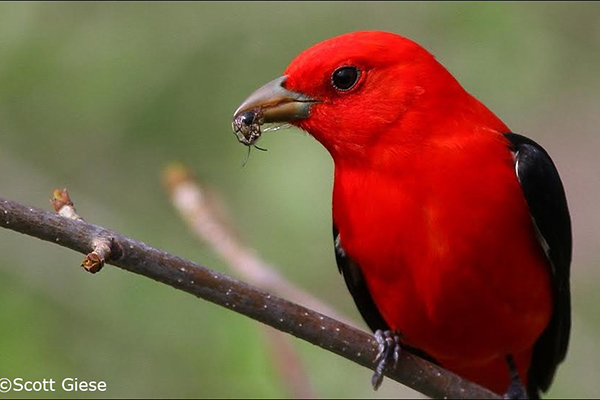
Wooded Wetland Birds (breeding)
This species group consists of birds that breed in hardwood swamps, which includes forest-dwelling woodpeckers, vireos, flycatchers, cuckoos, nuthatches, thrushes, warblers and a few other species, as well as shrub carr-affiliated species.
Historically, little has been published about wooded wetland breeding birds in northeastern Wisconsin. However, the west shore was largely covered by swamp conifer forest (1840s PLSS records from the WDNR Surface Water Data Viewer) with black spruce (Picea mariana) and balsam fir (Abies balsamea; T. Erdman, pers. comm.), so it is likely that birds of northern wet mesic forest habitat were more abundant, diverse and widespread than they are today in the LGBFR AOC. During the 1800s and early 1900s, a significant amount of Wisconsin’s forests was heavily logged and have since been converted to farmland, development and early successional forests dominated by Populus spp. and other pioneer tree species (Frelich 1995).
Multiple confirmed breeding records have been reported for forest-dwelling species Baltimore Oriole (9), Black-capped Chickadee (8), Gray Catbird (6), Northern Flicker (6), Blue Jay (5) and Downy Woodpecker (5) and shrub carr-affiliated species Cedar Waxwing (6), Yellow Warbler (6), American Goldfinch (5) and Song Sparrow (5; eBird 2017). Presently, no confirmed breeding records have been reported in the LGBFR AOC for Black-billed Cuckoo, Broad-winged Hawk, Brown Creeper, Mourning Warbler, Northern Waterthrush, Ovenbird, Red-breasted Nuthatch, Red-eyed Vireo, Ruffed Grouse, Scarlet Tanager, Winter Wren, Yellow-billed Cuckoo and Alder Flycatcher, except for “probable” (e.g., agitated adult, courtship display) or “possible” (e.g., singing male) breeding records (eBird 2017); however, Alder Flycatcher more frequently use alder thickets in northern Wisconsin. Black-and-white Warbler and Red-shouldered Hawk were not reported at all during the breeding season in the LGBFR AOC, though they do use forested wetlands in this region for breeding.
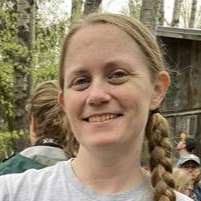
Ask an Expert
As a proud alumna of UW-Green Bay, Erin Giese understands the need to provide hands-on experiences for students. She's committed to training the next generation of scientists who help to improve the LGBFR AOC. If you have questions, she can help!